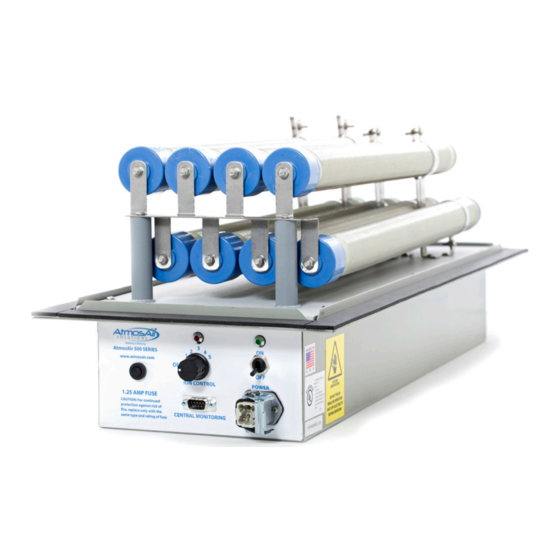
AtmosAir 500 Series Installation, Operation And Maintenance Manual
Hide thumbs
Also See for 500 Series:
- Installation, operation, maintenance manual (10 pages) ,
- Installation, operation and maintenance manual (10 pages) ,
- Installation, operation and maintenance manual (13 pages)
Table of Contents
Advertisement
Quick Links
Advertisement
Table of Contents

Subscribe to Our Youtube Channel
Summary of Contents for AtmosAir 500 Series
- Page 1 Installation, Operations and Maintenance Guide AtmosAir 500 Series...
-
Page 2: Product Overview
The number and size of the ionization tubes used is dependent upon the airflow, size of the space, and severity of the pollution and odors. The AtmosAir 500 series equipment is designed for minimal maintenance efforts. The 500 series has two components that require inspection and maintenance: 1. -
Page 3: Mechanical Installation
(now inside of the duct) to the outside of the duct. Place the AtmosAir unit onto the mounting bolts so that each bolt goes through the corresponding hole in the AtmosAir unit and the AtmosAir tubes go fully inside of the duct. -
Page 4: Electrical Installation
Electrical Installation Field install a junction box within 2.4m of the unit(s). Each 500 series unit is typically shipped with a 3m power lead in a flexible metallic conduit with a quick connect power plug on one end and bare wires on the other. -
Page 5: Operation
The maintenance requirements on an AtmosAir system are mainly site dependent; a dirtier environment requires more frequent maintenance. In general, quarterly or biannual maintenance is recommended along with tube replacement every two years. The local AtmosAir dealer can provide you with a maintenance/service contract. -
Page 6: Troubleshooting
If the light does not turn on, there is still a problem with delivering power to the system. If all external sources of failure are eliminated, the system should be serviced by a qualified AtmosAir technician. - Page 7 If the fuse continuously blows, or if the voltages are lower than expected, then the system should be serviced by a qualified AtmosAir technician. If there seems to be a gradual loss of effectiveness, check the tubes and clean them if necessary.
- Page 8 CAUTION! DO NOT TOUCH ANYTHING METAL DURING THIS TEST! HIGH VOLTAGE AT FULL ‘POTENTIAL’! If it’s not a fuse blow issue, I’m afraid that the unit in question may need to be returned (contact: rma@atmosair.com and complete: https://www.atmosair.com/rmaform)... Customers should not attempt to open and repair our units.
- Page 9 Tube Installation Instructions 1. Ensure that all mains power is disconnected from the unit. 2. Carefully remove tubes from packing and check that the tube is free of damage or loose cap to tube connection. 3. Inspect the outer metal mesh and adjust, if possible, to maintain a 1.25cm distance from the end cap.
- Page 10 Tube Removal Instructions 3. Ensure that all mains power is disconnected from the unit. 4. Loosen the screw in the end clamp around the tube. It is not always necessary to completely unclamp the tube; however, sometimes it is much easier to remove the tube by doing so.
-
Page 11: Quick-Clean
Quick-Clean Disconnect the system from the main power before performing any cleaning. Even if no person or object is in contact with the system, the air flow may inadvertently cause dirt, debris, water, or other objects to come into contact with an electrode or both electrodes and create a spark, if the system is operating. - Page 12 Improper installation by tightening the tube clamps or the end nut on the 500 series could cause the end cap to separate from the tube. AtmosAir Solutions mission is to bring and restore every indoor environment the same clean and pure quality air that is typically found at higher mountain elevations.






Need help?
Do you have a question about the 500 Series and is the answer not in the manual?
Questions and answers